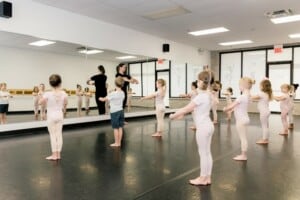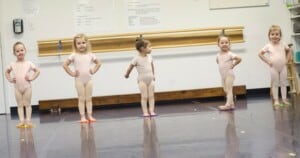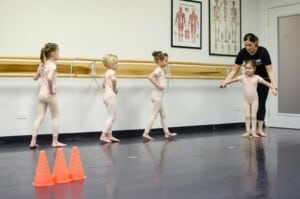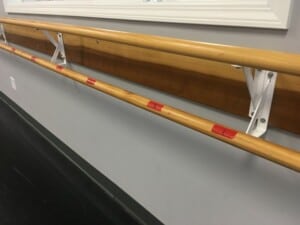Preschool Classroom Success: Space Markers
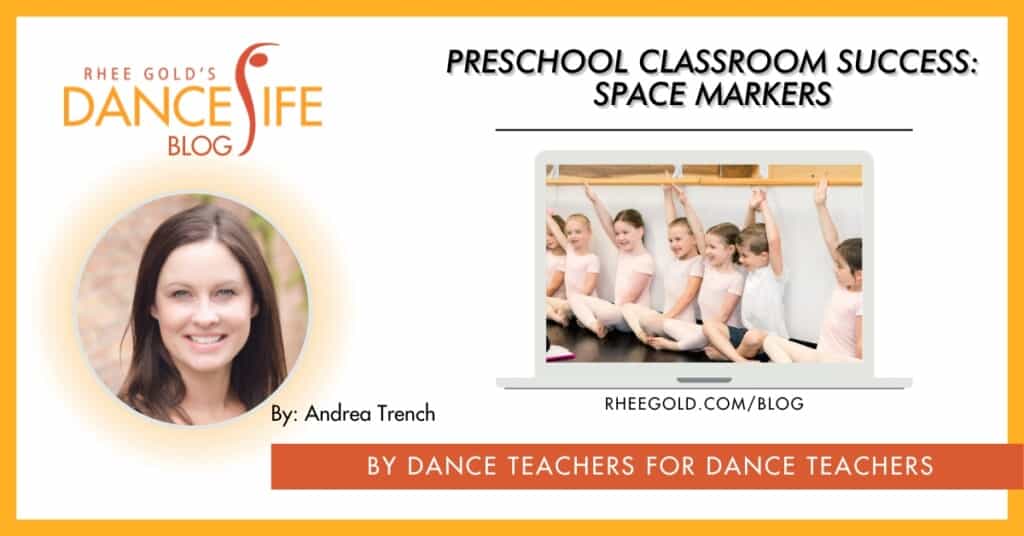
When I look at my overall classroom management plan one of the most effective strategies that has helped with classroom flow (besides my voice) has been space markers. Today I’m sharing how space markers can increase spatial awareness, improve the choreographic process, and set the foundation for across the floor work as your students progress through your program.
When it comes to space markers, you could use portable markers that can be picked up and moved whenever needed, such as poly spots, or stationary markers that cannot be easily moved, such as floor tape. Both create excellent visuals that assist students in various tasks. I like to use a combination of the two depending on the age of my students and the activity at hand.
Home Base Visual
Space markers create a visual of a dancer’s personal space, their home base. As you move through your class it’s easy to direct dancers back to their home base during transitions. For example, after our welcome freeze dance in my 4-5 year old class, I’ll direct the dancers to put their scarves away then stand in their best first position on their tape mark. After our warm up circle in my 1st-3rd grade class, I’ll direct dancers to get some water and return to their tape marks to work on performance choreography. Giving our students clear instructions on what they should be doing, during transitions, helps us keep the flow of class moving. As soon as I put my scarves away or get a sip of water, the dancers will be on their spots ready for the next activity.
In addition, assigning tape marks gives them ownership of their dance space. The older the dancers are the more you can change their tape marks, so they can experience different areas of the studio. However, when it comes time for learning performance choreography, keeping their spots the same will get them comfortable on their performance spot, allowing them to focus more on remembering the choreography and less on where they should be dancing.
Teaching Formations
Incorporating formation changes inside your class structure will also make the choreographic experience much more successful. For example, when warming up have your dancers (ages 4+) begin in two lines on their tape mark. Throughout the warm up incorporate line changes as well as moving from two lines to one circle. When it’s time for creating performance choreography, utilizing these formation changes will be a breeze because they have been practicing them all season long.
When you use tape marks as their space markers you are increasing their spatial awareness as they move through these formations. Their tape marks are their “spots”. When they change lines they can clearly see that they are between tape marks. We call these their “not spots”. Practice saying “spots” and “not spots” as you switch lines. By adding visuals, auditory cues, and repeating the movement, you are offering a multi-sensory experience that will make learning more effective.
For circle formations, everyone begins on their tape marks. Front line faces stage right, back line faces stage left, and they follow the person in front of them creating a circle. Marking center stage with a taped X or a poly spot will provide a visual of the center of the circle. Again, creating awareness of where they should be as they move through space. You can practice ballet walks, runs, skips, chassés, side slides, etc. as you travel.
Across the Floor
Across the floor activities vary throughout the stages of development. For caregiver/tot- preschoolers, you can place poly spots in a line on one side of the studio. Each dancer has a different color. This is their “home” spot. Place the same color across from them in the center of the room. This is their “away” spot. All dancers travel at the same time. Once they understand how to move from their “home” spot to their “away” spot, you can move their “away” spot to the other side of the room.
Caregiver/Tot classes can do this activity with their grown-ups being at their “away” spot. Wave hello as they travel forwards to their “away” spots and goodbye as they travel backwards to their “home” spots.
As your dancers begin to understand how to move from one spot to another, you can begin to introduce moving on a diagonal from spot to spot one or two dancers at a time. Because they know to move from one color spot to the same color spot, keep it the same as they move in the diagonal. For example, from one corner they move from green spot to green spot and from the other corner, they move from yellow spot to yellow spot.
It’s important to not forget to teach your young dancers how to wait for their turn as you begin traveling one or two at a time across the floor. Beginning at the age of 4, I like my dancers to wait standing at the barre. This helps to keep my dancers ready so we can get through more skill development. Just like how we move along our train track before our obstacle course, we use tape marks along the barre. When the tape mark in front of them is empty, they move up the line.
It’s never too early to teach our students how to move in their own personal space without bumping into others, how to create straight lines and windows so all can be seen on stage, and how to move across the floor effectively to maximize class time together. Space markers make it easy for even our youngest students to understand the foundation of these concepts. If you’re not already using space markers in these ways, I encourage you to give it a try! Be sure to report back your experience in the comments below.
Happy Exploring!
Andrea Trench is dedicated to helping dance teachers create and deliver content that is research-based and developmentally appropriate for children under the age of 6. Her primary focus is classroom management, conceptual teaching, and foundational movement skill development in early childhood dance education. In addition, Andrea uses her 12 years of experience as a partner in a dance studio to inspire, equip, and empower educators.







